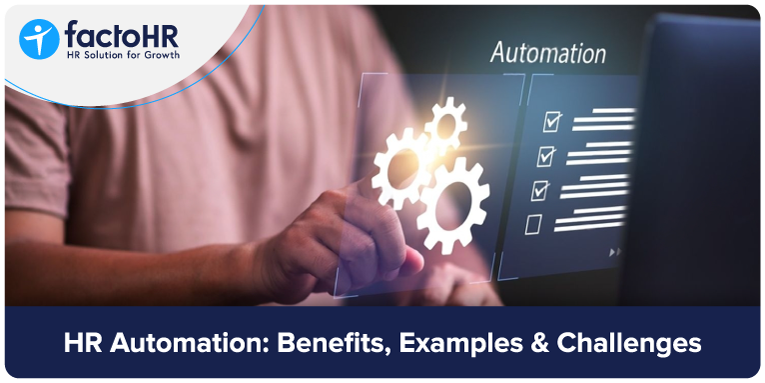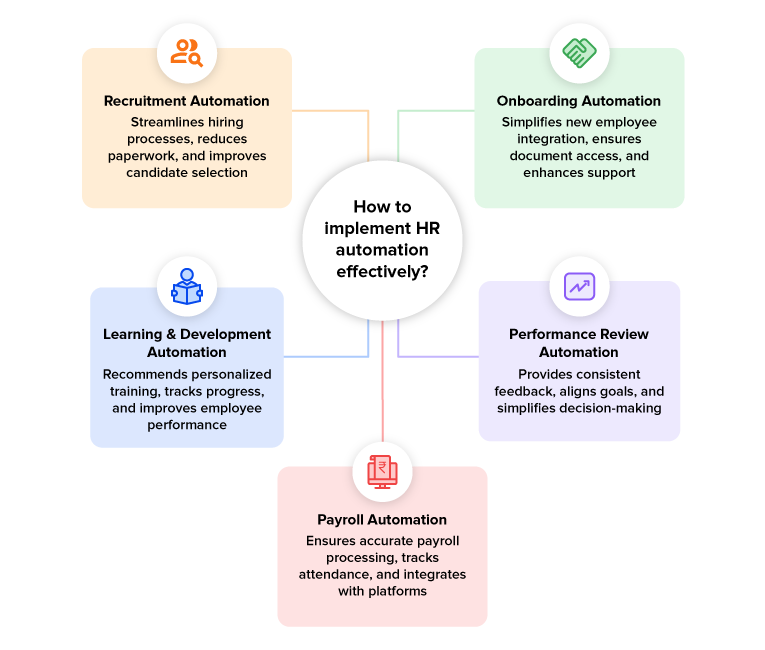What is HR Automation? Benefits, Examples & Challenges

Table of Contents
Can organizations get HR-related results through HR digital transformation instead of traditional methods? HR professionals face various challenges when it comes to paper-based or traditional HR practices. Organizations may struggle to keep pace with the rapid changes in technology and legal requirements. Also, HR professionals find it difficult to manage a diverse workforce and increase employee engagement. They are always under constant pressure to balance employee needs with the changing work culture.
These challenges have led to the evolution of HR functions in every modern organization. The increase in digital tools and automation in HRM is now changing many workplaces. HR departments can manage their repetitive administrative tasks to avoid manual errors and increase the effectiveness of core HR practices. This article discusses various examples of HR automation and the challenges of implementing automation in HR, with best practices.

What is HR Automation?
HR automation includes the use of technology to simplify and automate some of the administrative HR tasks. When HR processes are streamlined, it helps HR professionals focus on other important tasks to increase their efficiency. Some routine HR tasks are managed through HR software, like recruitment and payroll processing. Automation in human resources includes:
- Use of algorithms and software for tasks previously done manually.
- Processes like talent management and employee development can be managed efficiently.
- Reduction in manual efforts and errors for more accurate results.
- Tools like HRIS can be integrated into a centralized platform.
It can also help automate the employee onboarding process by providing welcome messages, and employees can manage their data through the employee self-service portals. Note that HR automation is used to help HR professionals perform their jobs more effectively. Some interpersonal conflicts, like cultural or ethical decision-making, cannot be automated.

How Automation in HR Management Works?
HR automation works through specialized software and AI-driven tools. These HR automation tools organize core HR processes and help professionals make informed decisions. Rule-based modules in workflow automation perform predefined tasks based on specific events or data. For instance, the software assists with onboarding by sending notifications with instructions to new employees and providing access to necessary documents for their initial tasks.
Another way is through task routing, i.e., directing work requests or tasks to the right individual or team in the HR department. This makes HR operations more effective and helps reduce on-the-job delays. AI-driven virtual assistants or chatbots can also manage HR-related queries in real time. They help employees solve their questions and provide support. Robotic Process Automation, or RPA, simplifies HR tasks using bots that copy human actions, like typing applications.
HR software can also integrate with third-party applications. This helps HR professionals reduce the need for manual entries and maintain data consistency. The software also includes dashboards to get insights on various key HR metrics for easy decision-making. This helps HR professionals reduce mistakes and save time for other important tasks.

What are the Examples of HR Automation?
Automation in HR can reshape the way organizations manage their workforce. Some of the HR automation examples are mentioned below for further information.

Recruitment and Hiring
Sometimes, HR teams lose efficiency due to a lack of communication or excessive paperwork in the recruitment process. They might spend unnecessary time on unproductive admin work, like screening resumes, which reduces productivity. Automation in recruitment includes pre-employment assessments and selecting candidates based on set criteria, leading to more efficient processes.
Onboarding
Employee onboarding includes pre-boarding activities and collecting documents to sign forms. New employees need ongoing support, such as raising requests for new devices or giving access to tools during their first few weeks. HR automation can help organizations by automating tasks like paperwork and access to necessary documents so that new employees can start their work easily.
Payroll and Attendance
A manual attendance system leads to challenges, like buddy punching or a lack of real-time data tracking. Also, manually calculating work hours for payroll processing leads to errors. Automation helps track and calculate employee work hours for accurate payroll processing. It can integrate with third-party platforms and centralize data for organizations to analyze or audit.
Performance Reviews
Organizations face issues with performance reviews, like inconsistent feedback or the proper alignment of individual goals with company objectives. Automation of performance review tracking offers organizations valuable insights into review specifics and helpful feedback. This automation simplifies the process and helps make accurate decisions.
Learning & Development
Numerous organizations struggle with selecting training programs that will efficiently benefit their employees’ performance. Additionally, assessing the effects of training on staff and technology advancement complicates the issue. HR automation helps track progress and give personalized training recommendations. The software can identify employees’ skills gaps and suggest training programs. This will help improve their performance and increase productivity.

What are the Benefits of HR Automation?
HR automation has multiple benefits that help HR professionals save time on repetitive tasks. It also gives them more time to make valuable decisions for their workforce—HR tools transition processes from manual to digital, enhancing HR functions. There are multiple benefits of HR automation for any business. Some of them are mentioned below:
- It speeds up HR process automation, like payroll and benefits administration. This helps improve productivity levels.
- It can reduce human errors by eliminating the need for manual data entry.
- The software provides data security and compliance with government regulations.
- Employees can access self-service portals to update their information, reducing HR’s workload.
- Automating repetitive and time-consuming tasks helps save HR professionals time.
- Data reports can be generated to make smart decisions related to the workforce.

What are the Challenges of Implementing Automation in HR?
Automation in HR offers multiple benefits, but it also comes with some challenges. Automation can improve HR processes, but sometimes there are some intangible aspects that need to be considered. The software does not have emotional intelligence or soft skills to address employee needs. Sensitive and complex human interactions cannot be automated to improve employee satisfaction. Some of the other challenges are mentioned below for more understanding.
- Implementing HR automation software requires a high initial investment cost for system configuration and data migration.
- Employees may not know how to use the new system and how it will affect their job roles.
- The system lacks emotional intelligence and empathy in interactions. This can prove to be a challenge for HR professionals in people management.
- It stores employees’ sensitive data, which can lead to a data breach or unauthorized access.
- Some independent HR modules can be difficult to integrate with the existing systems.
What are the Most Important Automation Features HR Software Should have?
Organizations should choose the right HR software according to their needs and requirements. This helps achieve goals and increases productivity. Some of the important features HR software should have are mentioned below.
Recruitment and Hiring Tools
Recruitment and hiring tools should automate repetitive tasks like screening candidates. The tools can also identify candidates from various sources, like social media, to simplify the process. When new employees are onboarded, the tools can provide relevant help for ongoing support. They can automatically send emails and notifications to schedule an interview in the hiring process. This will benefit organizations by improving their recruitment processes and reducing the overall cost of hiring.
Employee Self-Service
The employee self-service portal helps employees access and update their information. The portal allows employees to request time off or download their payslips. It can also help employees submit their expense reports for reimbursement purposes. If employees need to upskill themselves, they can enroll in training programs. This approach enables employees to enhance their satisfaction through personal task management.
Payroll and Benefits Tools
Payroll and benefits tools include calculating payroll and benefits administration. HR professionals can manage direct deposits and tax withholding without tracking them manually. The HR system helps manage employee eligibility for benefits programs. The system should provide benefits information to employees and help improve the employee experience.
Time and Leave Tracking Tools
Time and leave tracking tools should accurately manage and schedule employees’ shifts. Using a biometric attendance system, the system should automatically calculate employees’ time in/out. Employees can submit their leave requests through the web or mobile portal to simplify the approval process. Managers can also get notifications on pending approvals of employees’ requests, like leave approval or expense claims.
Performance Evaluation Tools
Performance evaluation tools include feedback tracking and collecting data for analysis. The software helps reduce bias as it uses data-driven insights for evaluations. It can also identify trends and patterns for improvement in employees’ work. From the performance data, training needs can be identified for the employees.
Employee Training Tools
This module includes built-in tools for employee training and development programs. HR teams can manage and track every employee’s learning stages for career improvement. AI suggests personalized training programs based on employees’ skills to improve learning efficiency.
Talent Management and Retention Tools
Talent management tools should improve key processes, like recruitment and performance management. These tools can collect feedback on employee experiences and work towards improving them. Retention tools should focus on the common reasons why employees resign. For example, why is an employee taking too many unplanned leaves, and what actions can be taken to boost their engagement?
Data Analytics Tools
Data analytics tools help HR professionals analyze data to make informed decisions. These insights provide detailed reports and identify problems related to the workforce. The data aids in predictive analysis by helping to comprehend outcomes related to turnover and performance gaps. This way, HR process automation can be more efficient in recruitment and performance.
Integration Tools
Integration tools should exchange data between different systems for better decision-making. They should also integrate and synchronize data with other third-party systems to identify areas for improvement based on reports.

What are the Best Practices for Adopting HR Automation?
After knowing some of the most important features any HR software should have, we have mentioned some of the best practices for adopting HR automation. Note that HR automation is ineffective if implemented without any assessment process. These are:
Set Clear Goals and Success Metrics
The process starts by defining HR goals, which should be directly linked to business strategies. HR professionals should choose metrics, like Key Performance Indicators (KPIs), to determine whether the objectives are met.
Choose the Right HR Automation Tools
Organizations should identify which HR processes need automation. They should know their needs and solutions to improve effectiveness through HR automation tools
Provide Training and Support to Staff
Employees should be provided with training and support to understand the automation benefits and learn how the new system works. Organizations should focus on continuous training to answer questions or concerns.
Regularly Review System Performance
Monitor the performance of the automation tools to identify areas for improvement. Ensure goals are met to maximize the return on investment for HR tools.

What is the Future of HR Automation?
HR automation offers numerous advantages, prompting many organizations to streamline their HR processes. Some of these benefits are increased efficiency and a reduction in HR’s workload. The latest update includes AI in HR, which increases the HR department’s overall productivity.
Ethical and Responsible AI
In HR automation, AI plays an important role through chatbots and voice technology. These tools solve concerns like bias and data protection. The company’s sensitive data should be protected with powerful AI algorithms and comply with government regulations.
Employee Experience Enhancement
HR and automation should be used together to enhance the employee experience. Personalization in self-service portals and AI-powered learning platforms increases employee satisfaction.
Solutions for Remote Work Support
After COVID-19, demand for remote and hybrid work arrangements increased. Because of this, a cloud-based HR module with an ESS portal is in high demand, as it improves employee experience and the efficiency of HR processes. The software should also enhance collaboration between teams regardless of employees’ location.
Focus on Employee Well-Being
Organizations should emphasize employee well-being and mental health, a key concern for many employees today. Automations in HR and AI can help develop wellness programs. Some examples of wellness programs are a self-help guide and access to mental health resources.

Conclusion
Utilizing HR automation effectively minimizes the need for HR professionals to manage daily operations. This will help them create more efficient and creative ways for an organization to function. HR teams can focus on other important tasks, like improving company policies. The objective is to create a positive work culture and an engaging environment to increase productivity.
factoHR helps businesses create more efficient HR processes. The software is scalable according to any organization’s requirements, from recruitment to retirement. Schedule a demo to learn more.
How to Automate the HR Process?
When an organization wants to automate its HR processes, it is necessary to identify the areas for repetitive HR tasks. Afterward, organizations should choose HR software that can meet specific needs, such as HRIS or HRMS.
Why is HR Automation Important?
HR automation is important for various reasons, like
- Increased Efficiency and Productivity
- Enhanced Employee Experience
- Cost Savings
- Improved Compliance
- Data-Driven Decision Making
Is HR Automation Suitable for Small Businesses?
HR automation is suitable for small businesses as it manages HR processes, like recruitment and payroll processing. They can use HR automation software to improve their efficiency and employee productivity.
Will HR Jobs be Automated?
HR jobs will not be automated as they are expected to support HR professionals in their daily tasks. This frees them up for other important tasks, such as developing company policies and increasing employee engagement.
Grow your business with factoHR today
Focus on the significant decision-making tasks, transfer all your common repetitive HR tasks to factoHR and see the things falling into their place.

© 2025 Copyright factoHR


